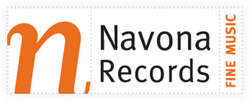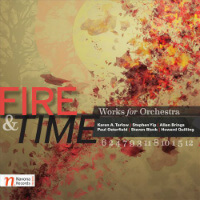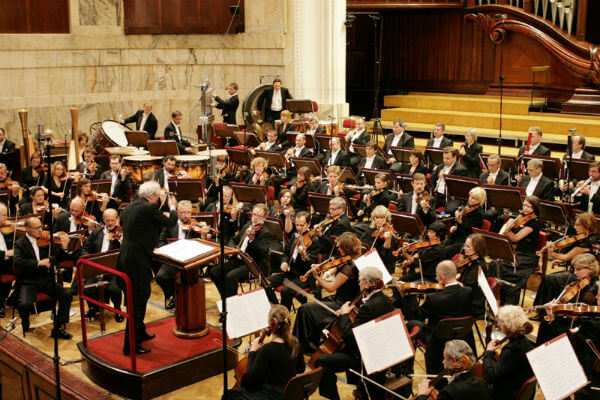 None of the works on this compilation disc, composed from 1993 to 2009, are particularly adventurous. Anyone, or any orchestra, not afraid of Bartok, late Stravinsky or Messiaen would find the selections attractive and interesting. These six short and diversely inspired works are worthy of preservation on disc and even a second hearing or two.
None of the works on this compilation disc, composed from 1993 to 2009, are particularly adventurous. Anyone, or any orchestra, not afraid of Bartok, late Stravinsky or Messiaen would find the selections attractive and interesting. These six short and diversely inspired works are worthy of preservation on disc and even a second hearing or two.
Karen Tarlow’s Kavanah (Remembrance) from 1993 opens the program (Kavanah is defined as “the mindset often described as necessary for Jewish rituals“). This brief, almost stream- of-conscience prelude uses dreamy impressionism, a Klezmer outburst by the clarinets and trumpets, and even a hint of the Dies Irae to illustrate the prayerful preparation for sacred ritual. The work is atmospheric and colorfully orchestrated, but at just over three and a half minutes, it goes by too quickly to leave much of a lasting impression.
Stephen Yip’s 2009 The Legendary Phoenix is a short piano concerto inspired by an ancient Korean bronze incense burner. The artwork depicts a dragon and phoenix and is in four pieces, and the composition is cast in four continuous sections. Beginning fitfully and mysteriously with downward moving motifs, the 17-minute work increases in intensity and drama with the piano taking a lead role. A “grand tutti” coalesces the themes and different groups, leading to a strikingly intense and soaring closing section, the piano exploring its highest register. Pianist Martin Levicky handled the virtuoso part with aplomb. The Moravian Philharmonic under Petr Vronsky performed admirably in what must have been some quite unfamiliar music.
 Allen Brings’ Short Symphony # 1 for strings dates from 1996. In four short movements of about 13 minutes total the composition is quite derivative of Batrok; think the opening movement of Music for Strings, Percussion and Celesta without the percussion and celesta. Vronsky’s Moravian Philharmonic sounded full and sharp when needed, they could probably do a fine Bartok.
Allen Brings’ Short Symphony # 1 for strings dates from 1996. In four short movements of about 13 minutes total the composition is quite derivative of Batrok; think the opening movement of Music for Strings, Percussion and Celesta without the percussion and celesta. Vronsky’s Moravian Philharmonic sounded full and sharp when needed, they could probably do a fine Bartok.
Paul Osterfield’s 2006 Monadnock is a musical portrait of the famous Mt. Monadnock in eastern New Hampshire. Like the mountain, Osterfield’s Monadnock is craggy, imposing and ultimately impressive. The 11-minute tone poem literally rises from nothing, as does the mountain, to a bright and brassy climax. As one climbs upwards, the scenery shifts from trees and flora to cold, craggy stone. The music emulates this with percussive outbursts, dramatic fanfares and icy wind chords. The view from the top is breathtaking and the brass fanfare returns to celebrate the vast, imposing vista. This is not a programmatic climb to the top as is Richard Strauss’ Eine Alpensinfonie but musical impressions of various views of the mountain. Impressively performed by the Kiev Philharmonic under Robert Ian Winstin, Monadnock made a strong impression; likely the finest piece on the disc.
Steven Block’s Shadows from 1993 is a pointillistic, tuned percussion filled essay inspired by a more psychological definition of shadows. Thus the music is basically bright and almost glassy with prominent harp, piano and celesta. A bright exploration of color and shading, the work is attractive and more than reminiscent of Messiaen. According to the notes, Shadows is supposed to be a part of a 4-movement symphony. I could find no evidence that the symphony has ever been completed. Robert Stankovsky conducted the Slovak Radio SO.
If Brings’ Symphony channeled Bartok, then Howard Quiling’s 1997 From Quiet Beginnings evoked the spirits of Hindemith and Walton. Written for the city of Bakersfield, CA for its centennial, the work is chock full of fanfares, long winding themes on strings and horns and commanding timpani all combined in a generally genial, celebratory mood. The most backward looking of all the works on the disc, it is certainly well constructed and nicely done by the Warsaw Philharmonic, Gil Rose, Conductor.
Navona’s generous musical program is enhanced by an informative app in a data file included on the disc: biographical information on the composers, extensive notes, study scores for each piece plus two ring tones (which I could not get Real Player to play, but that may be a problem with my system). The recorded sound, mostly from the last three years (with the exception of the Tarlow recorded in 1995 and the undated Block) is quite clear and spacious
Listeners seeking ear-opening new works will need to look elsewhere. Listeners wanting a fine compilation of American works for orchestra from the last 20 years will find this release essential.
Fire and Time, Works for Orchestra by Karen Tarlow, Stephen Yip, Allen Brings, Paul Osterfield, Steven Block, Howard Quilling (Navona Records NV7871) | Buy on Amazon
–
Don Clark is a classical music enthusiast, free lance concert reviewer and blogger. Follow him on Twitter: @Donaldopato.























